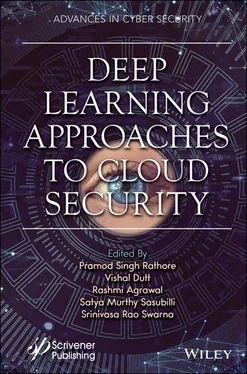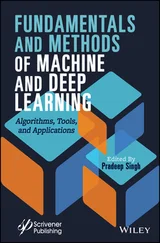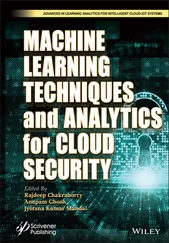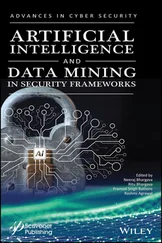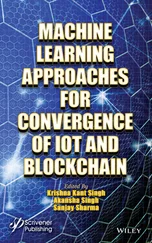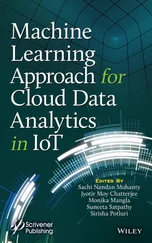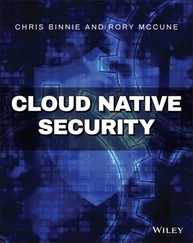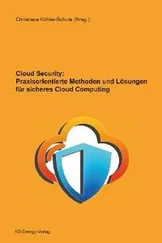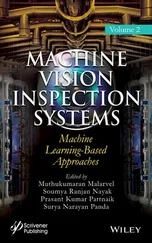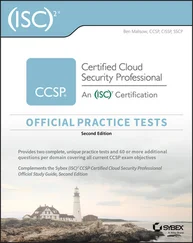1 Cover
2 Title Page
3 Copyright
4 Foreword
5 Preface
6 1 Biometric Identification Using Deep Learning for Advance Cloud Security 1.1 Introduction 1.2 Techniques of Biometric Identification 1.3 Approaches 1.4 Related Work, A Review 1.5 Proposed Work 1.6 Future Scope 1.7 Conclusion References
7 2 Privacy in Multi-Tenancy Cloud Using Deep Learning 2.1 Introduction 2.2 Basic Structure 2.3 Privacy in Cloud Environment Using Deep Learning 2.4 Privacy in Multi-Tenancy with Deep Learning Concept 2.5 Related Work 2.6 Conclusion References
8 3 Emotional Classification Using EEG Signals and Facial Expression: A Survey 3.1 Introduction 3.2 Related Works 3.3 Methods 3.4 BCI Applications 3.5 Cloud-Based EEG Overview 3.6 Conclusion References
9 4 Effective and Efficient Wind Power Generation Using Bifarious Solar PV System 4.1 Introduction 4.2 Study of Bi-Facial Solar Panel 4.3 Proposed System 4.4 Applications of IoT in Renewable Energy Resources 4.5 Conclusion References
10 5 Background Mosaicing Model for Wide Area Surveillance System 5.1 Introduction 5.2 Related Work 5.3 Methodology 5.4 Results and Discussion 5.5 Conclusion References
11 6 Prediction of CKD Stage 1 Using Three Different Classifiers 6.1 Introduction 6.2 Materials and Methods 6.3 Results and Discussion 6.4 Conclusions and Future Scope References
12 7 Classification of MRI Images to Aid in Diagnosis of Neurological Disorder Using SVM 7.1 Introduction 7.2 Methodology 7.3 Results and Discussions 7.4 Conclusion References
13 8 Convolutional Networks 8.1 Introduction 8.2 Convolution Operation 8.3 CNN 8.4 Practical Applications 8.5 Challenges of Profound Models 8.6 Deep Learning In Object Detection 8.7 CNN Architectures 8.8 Challenges of Item Location References
14 9 Categorization of Cloud Computing & Deep Learning 9.1 Introduction to Cloud Computing 9.2 Introduction to Deep Learning 9.3 Conclusion References
15 10 Smart Load Balancing in Cloud Using Deep Learning 10.1 Introduction 10.2 Load Balancing 10.3 Load Adjusting in Distributing Computing 10.4 Cloud Load Balancing Criteria (Measures) 10.5 Load Balancing Proposed for Cloud Computing 10.6 Load Balancing in Next Generation Cloud Computing 10.7 Dispersed AI Load Adjusting Methodology in Distributed Computing Administrations 10.8 Adaptive-Dynamic Synchronous Coordinate Strategy 10.9 Conclusion References
16 11 Biometric Identification for Advanced Cloud Security 11.1 Introduction 11.2 Literature Survey 11.3 Biometric Identification in Cloud Computing 11.4 Models and Design Goals 11.5 Face Recognition Method as a Biometric Authentication 11.6 Deep Learning Techniques for Big Data in Biometrics 11.7 Conclusion References
17 12 Application of Deep Learning in Cloud Security 12.1 Introduction 12.2 Literature Review 12.3 Deep Learning 12.4 The Uses of Fields in Deep Learning 12.5 Conclusion References
18 13 Real Time Cloud Based Intrusion Detection 13.1 Introduction 13.2 Literature Review 13.3 Incursion In Cloud 13.4 Intrusion Detection System 13.5 Types of IDS in Cloud 13.6 Model of Deep Learning 13.7 KDD Dataset 13.8 Evaluation 13.9 Conclusion References
19 14 Applications of Deep Learning in Cloud Security 14.1 Introduction 14.2 Deep Learning Methods for Cloud Cyber Security 14.3 Framework to Improve Security in Cloud Computing 14.4 WAF Deployment 14.5 Conclusion References
20 About the Editors
21 Index
22 End User License Agreement
1 Chapter 1 Figure 1.1 Biometric modalities [2]. Figure 1.2 Applications of Face-Land marking [4]. Figure 1.3 System architecture.
2 Chapter 2 Figure 2.1 Cloud computing services [3]. Figure 2.2 Types of tenant [4]. Figure 2.3 Multi-Tenancy models [5]. Figure 2.4 Multi-Tenant Cloud structure [6]. Figure 2.5 Concept of Cloud Security [7]. Figure 2.6 Securities in Multi-Cloud environments [7]. Figure 2.7 Multi-Tenancy services [8].
3 Chapter 4Figure 4.1 Survey of WECS.Figure 4.2 Bi-facial solar panel.Figure 4.3 Block diagram of the proposed system.Figure 4.4 DC motor with gear arrangement.Figure 4.5 Structure of proposed system.Figure 4.6 (a) Diagram of spoiler structure, (b) structure of spoiler design.Figure 4.7 Snapshot of bifarious solar panel in spoiler structure.Figure 4.8 Experimental setup of the proposed system.Figure 4.9 IoT features.Figure 4.10 Wind speed using IoT.Figure 4.11 Monthly average wind speed using IoT.Figure 4.12 Wind rose.Figure 4.13 Turbulence intensity using IoT.Figure 4.14 Turbulence intensity vs. wind speed (m/s).Figure 4.15 Comparison of gradient boosting and XG boost.
4 Chapter 5Figure 5.1 Proposed methodology.Figure 5.2 MICC dataset background mosaic model.Figure 5.3 Comparison of mosaic features.Figure 5.4 (a) Input frame 220 on VIP dataset, (b) Extracted SURF features, (c) ...Figure 5.5 (a) Input frame 220 on MICC dataset, (b) Extracted SURF features, (c)...
5 Chapter 6Figure 6.1 Proposed workflow.Figure 6.2 Working of decision tree.Figure 6.3 Main Window displaying user interface.Figure 6.4 Mean & standard deviation for urea and glucose (training data).Figure 6.5 Mean & standard deviation for urea and glucose (test data).Figure 6.6 Mean & standard deviation for creatinine (training & test data).Figure 6.7 Comparative analysis of accuracy & error of different classifiers cla...
6 Chapter 7Figure 7.1 FlowchartFigure 7.2 Filtration and CLAHE performed in the image.Figure 7.3 Skull Stripping.Figure 7.4 Otsu’s segmentation.Figure 7.5 Multi-class SVM training results.Figure 7.6 Multi-class SVM testing results.
7 Chapter 8Figure 8.1 CNN.Figure 8.2 Comparison of RCNN and SPPnet.Figure 8.3 Pooling.
8 Chapter 9Figure 9.1 Cloud computing.Figure 9.2 Service models.Figure 9.3 Advantages of cloud computing.Figure 9.4 Disadvantages of cloud computing.Figure 9.5 Experiments.Figure 9.6 Cat experiment.
9 Chapter 10Figure 10.1 Cloud load balancing.Figure 10.2 Working of load balancer.Figure 10.3 Load balancing system based on cloud computing.Figure 10.4 Impact of load balancing.Figure 10.5 Quantum isochronous parallel computing model.Figure 10.6 Phase isochronous parallel model.Figure 10.7 Dynamic isochronous coordinate strategies.Figure 10.8 Weak threshold procedures in DIC model.Figure 10.9 DIC model staleness portal dynamic adjustment procedure.Figure 10.10 A-DIC training block diagram.
10 Chapter 11Figure 11.1 Biometric identification.Figure 11.2 Biometric modalities.Figure 11.3 Biometric modalities measurement.Figure 11.4 Biometric identification flow chart.Figure 11.5 Biometric architecture of the cloud-based biometric identification s...Figure 11.6 (a) Set of features of dataset values. (b) Prediction of class label...Figure 11.7 (a) Set of features having no predefined labels. (b) Cluster formati...Figure 11.8 Deep learning architecture layout.
11 Chapter 12Figure 12.1 Deep learning strategies.Figure 12.2 Auto-encoders.Figure 12.3 Data deep feature maps.Figure 12.4 Speech recognition system.Figure 12.5 Feature extraction.Figure 12.6 Drug discovery.Figure 12.7 Image recognition.
12 Chapter 13Figure 13.1 Deep learning model [13].Figure 13.2 Intrusion in cloud.Figure 13.3 Real time network anomaly detection system.Figure 13.4 Deep learning based intrusion detection system.Figure 13.5 Architecture of IDS in cloud.Figure 13.6 Model of RNN [16].
13 Chapter 14Figure 14.1 Deep autoencoder.Figure 14.2 Denoising autoencoder.Figure 14.3 Deep autoencoder and denoising autoencoder.Figure 14.4 Restricted boltzmann machine.Figure 14.5 Recurrent neural networks.Figure 14.6 CNN.Figure 14.7 Generative adversarial networks.Figure 14.8 Recursive neural networks.Figure 14.9 Security in cloud computing.Figure 14.10 Firewall.Figure 14.11 WAF.Figure 14.12 Working of WAF.Figure 14.13 Cloud WAF.
Читать дальше
